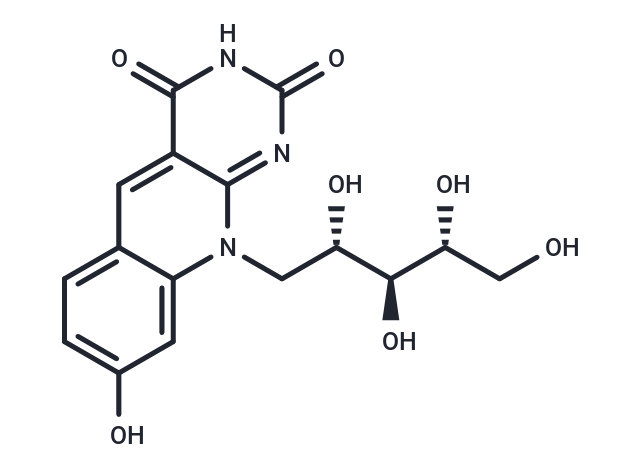Shopping Cart
- Remove All
 Your shopping cart is currently empty
Your shopping cart is currently empty

Coenzyme FO, a deazaflavin chromophore, is essential as a hydride acceptor/donor in the central methanogenic pathway [1][2].

| Pack Size | Price | Availability | Quantity |
|---|---|---|---|
| 1 mg | $148 | In Stock | |
| 5 mg | $363 | In Stock | |
| 10 mg | $539 | In Stock | |
| 25 mg | $873 | In Stock | |
| 50 mg | $1,180 | In Stock | |
| 100 mg | $1,620 | In Stock |
| Description | Coenzyme FO, a deazaflavin chromophore, is essential as a hydride acceptor/donor in the central methanogenic pathway [1][2]. |
| In vitro | Coenzyme FO is an intermediate in the synthesis of F420, while coenzyme F420 is a low redox potential electron carrier involved in energy metabolism, NADP reduction, oxygen detoxification, and sulfite reduction in methanogenic and certain non-methanogenic archaea. F420 can be reduced by F420-dependent hydrogenase and assists in resisting the antimicrobial action of macrophages in Mycobacterium tuberculosis[3]. |
| Molecular Weight | 363.32 |
| Formula | C16H17N3O7 |
| Cas No. | 37333-48-5 |
| Smiles | C([C@@H]([C@@H]([C@@H](CO)O)O)O)N1C=2C(=CC=3C1=CC(O)=CC3)C(=O)NC(=O)N2 |
| Storage | keep away from moisture | Powder: -20°C for 3 years | In solvent: -80°C for 1 year | Shipping with blue ice. | |||||||||||||||||||||||||
| Solubility Information | Ethanol: < 1 mg/mL (insoluble) DMSO: 8 mg/mL (22.02 mM), Sonication is recommended. | |||||||||||||||||||||||||
Solution Preparation Table | ||||||||||||||||||||||||||
DMSO
| ||||||||||||||||||||||||||

Copyright © 2015-2025 TargetMol Chemicals Inc. All Rights Reserved.